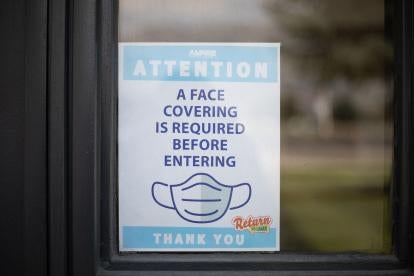In June 2022, the California Division of Occupational Health and Safety (“Cal/OSHA”) proposed initial non-emergency standards for COVID-19 prevention in the workplace that were intended to replace the current COVID Emergency Temporary Standards (“ETS”) set to expire on December 31, 2022. Following oral and written comments received from the public, the Cal/OSHA Standards Board (the “Board”) made further updates to the proposed non-emergency standard as of December 2, 2022 (the “Anticipated New Regulation”). It is expected that the Board will vote on the Anticipated New Regulation, with no further modifications, at its upcoming meeting on December 15, 2022. The Anticipated New Regulation would then become effective from January 1, 2023 through December 31, 2024.
Although the Anticipated New Regulation would extend many of the current ETS requirements, the changes are overall less onerous for employers. For example, the new standard would eliminate exclusion pay requirements, provide employers with more flexibility in meeting notice and COVID-19 workplace safety requirements, and reduce an employer’s COVID-19 testing obligations. While initially posed as a “permanent” standard back in June 2022, the Anticipated New Regulation would only apply through 2024, except for the reporting and recordkeeping requirements which are effective through 2026.
Employers may now prepare for compliance with the Anticipated New Regulation, considering the following notable changes:
-
Termination of Exclusion Pay. While the Anticipated New Regulation retains the requirement to exclude COVID-19 cases and other exposed employees, e.g., under the outbreak protocol, there is no requirement to provide exclusion pay to excluded employees. Please note, however, that the obligation to provide employees supplemental COVID-19 paid sick leave has been extended through December 31, 2022.
-
Injury and Illness Prevention Programs. Employers will have greater flexibility and control over their written Injury and Illness Prevention Programs (“IIPP”). Under the Anticipated New Regulation, employers will still be required to maintain a plan that addresses COVID-19 in the workplace, but most of the specific detailed requirements of the ETS have been eliminated. As before, an employer may incorporate its COVID-19 safety protocols into existing IIPPs or maintain separate, standalone COVID-19 programs, if preferred.
-
Return to Work Training. The Anticipated New Regulation removes the detailed COVID-19-specific training requirements and instead provides that COVID-19 must be covered as part of employers’ existing safety training requirements in connection with their IIPPs with details to be determined by the employer.
-
Reporting and Recordkeeping. While employers must continue tracking and recording COVID-19 cases and maintain such records securely and confidentially at least through 2026, the Anticipated New Regulation removes the requirement to report COVID-19 cases and outbreaks to a local health department unless requested or otherwise required by law. In addition, employers will no longer be required to maintain records of close contacts who were identified after a COVID-19 case.
-
Revised Definition of Close Contact. The Anticipated New Regulation incorporates the definition of a close contact that the California Department of Public Health (“CDPH”) adopted by order effective October 14, 2022, but builds in and adopts any updated definition that the CDPH may promulgate in the future. Currently, the definition of a “close contact” depends on the size of the indoor space, proximity of the individuals, and the length of exposure or contact. For indoor spaces of 400,000 or fewer cubic feet per floor (g., doctor’s office, mailroom, etc.), a close contact is someone who shares the same airspace for 15 minutes or more over a 24-hour period, regardless of the use of face coverings. For indoor spaces greater than 400,000 cubic feet per floor (e.g., warehouse, large retail space, open plan offices, etc.), a close contact must be within six feet of the COVID-19 case for 15 minutes or more over a 24-hour period. Offices, suites, rooms, waiting areas, break or eating areas, bathrooms, or other spaces separated by floor-to-ceiling walls are considered “distinct indoor spaces.” Thus, employees located in larger workspaces are subject to the “within six feet” standard, except for when they are in distinct indoor spaces. Practically speaking, employers may need to engage in more nuanced factfinding regarding workplace locations to identify close contacts of a COVID-19 case or choose to utilize the more inclusive definition if the worksite includes several distinct indoor spaces.
-
COVID-19 Testing. The Anticipated New Regulation will no longer obligate employers to provide COVID-19 testing at no cost or during paid time to all employees in an exposed workplace. Employers will still need to provide such testing to those employees who meet the revised definition of a close contact.
-
Ventilation. To improve ventilation and prevent transmission of COVID-19, the Anticipated New Regulation requires employers to take one or more actions to improve ventilation, by either maximizing the supply of outside air to the extent feasible, applying the highest level of filtration efficiency compatible with existing mechanical ventilation systems, and/or utilizing High Efficiency Particulate Air (HEPA) filtration units.
-
Outbreaks. The Anticipated New Regulation permits employers to end outbreak procedures when there is only “one or no new COVID-19 cases within a 14-day period.” The current ETS requires zero new cases within the relevant period before employers may end outbreak procedures.
-
Notice Requirements. Employers must continue to notify employees (and their representatives, if applicable) and independent contractors who had a close contact with a COVID-19 case. The Anticipated New Regulation requires that notice be provided “as soon as possible” and in no case longer than needed to comply with exclusion requirements. However, it also incorporates the requirements of Labor Code § 6409.6 or any successor law, which currently continues to require that notice be given to a close contact within one business day, among other requirements. AB 2693, signed into law on September 29, 2022, extended certain COVID-related requirements, including Labor Code § 6409.6, until January 1, 2024. As such, employers will need to continue complying with the one-business day notice requirement likely until at least January 1, 2024, though there are additional notice options in the new law, including posting the notice.
What California Employers Should Do Now
-
Continue to comply with the current ETS until it expires on December 31, 2022.
-
Become familiar with the new requirements of the Anticipated New Regulation.
-
Work with counsel to review and assess existing COVID-19 Prevention Programs to determine whether modifications should be made and whether it makes sense to incorporate COVID-19 safety protocols into IIPPs or maintain these protocols separately for their particular workplaces.
Alexandria Adkins contributed to this post.




 />i
/>i

